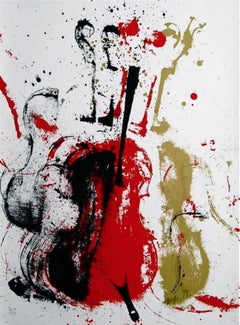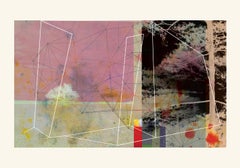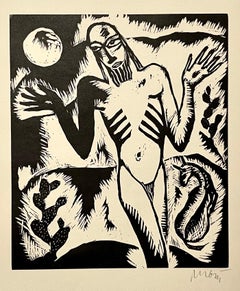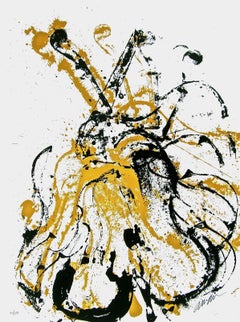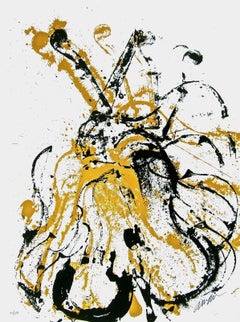Arman Landscape Prints
French, 1928-2005
Arman was born in Nice, France, in 1928, and showed a talent for painting and drawing as a child. He studied at the the Ecole Nationale des Art Décoratifs in Nice followed by studies at the École du Louvre in Paris.
In his early years he focused on abstract paintings. Then, in 1957, he became interested in common objects as works of art. He first did what came to be called his "allures d"objet" (object impressions), where he would dip an object into paint and press it on canvas thus leaving the object's shadow or impression. Then he decided the object itself was worth paying attention to and started to treat them in his own way. His intention was to remove the material purpose of an object so that its only remaining function was to "feed the mind" as a work of art. What better way to achieve that result than by breaking, slicing or even burning objects such as violins, telephones, typewriters or even whole cars? He also made objects useless by accumulating them, such as 2,000 wristwatches in a Plexiglass box that all kept different time.
Once emotionally detached from the circumstances associated with a broken object, the viewer could grow to appreciate its abstract beauty; so, in a sense, Arman was literally teaching that things one never thought could be regarded as attractive could indeed turn out to be so. Through this achievement, Arman gained worldwide recognition and is regarded as one of the most prolific and inventive creators of the late 20th century.
His work can be found in the collections of numerous museums including the Metropolitan Museum of Art in New York, the Tate Gallery in London and the Centre Pompidou in Paris.
Arman’s work has also been exhibited in galleries, museums and public spaces worldwide including the Musée D’Art Contemporain in Tehran, Iran; the Museum of Art in Tel Aviv, Israel; the Musée Des Arts Decoratifs and Opéra De Paris in France; the La Jolla Museum of Contemporary Art in California; and the Museum of Arts and Design and the Guggenheim in New York
He died in 2005 in New York.
(Biography provided by Rosenbaum Contemporary)
to
3
3
3
3
Overall Height
to
Overall Width
to
3
1
1
1
1
3
3
127
139
132
128
113
3
Artist: Arman
Glowing Guitar, Arman
By Arman
Located in Fairfield, CT
Artist: Arman (1929-2005)
Title: Glowing Guitar
Year: 1978
Edition: 150, plus proofs
Medium: Silkscreen on Arches paper
Size: 30 x 22.25 inches
Condition: Excellent
Inscription: Sign...
Category
1970s Abstract Expressionist Arman Landscape Prints
Materials
Screen
Violent Violins, Arman
By Arman
Located in Fairfield, CT
Artist: Arman (1929-2005)
Title: Violent Violins
Year: 1978
Edition: 16/150, plus proofs
Medium: Silkscreen on Arches paper
Size: 30 x 22.25 inches
Condition: Excellent
Inscription: ...
Category
1970s Abstract Expressionist Arman Landscape Prints
Materials
Screen
Yves Kline Violins, Arman
By Arman
Located in Fairfield, CT
Artist: Arman (1929-2005)
Title: Yves Kline Violins
Year: 1978
Edition: 102/150, plus proofs
Medium: Silkscreen on Arches paper
Size: 30 x 22.25 inches
Cond...
Category
1970s Abstract Expressionist Arman Landscape Prints
Materials
Screen
Related Items
L0320-Contemporary, Abstract, Modern, Pop art, Surrealist, expressionist, birds
By Francisco Nicolás
Located in London, London
Building a home
Digital pigment print Ultrachrome ink on Fabriano Rosaspina paper. Hand signed by the artist, and certificate of authenticity. (Unframed)
His work has been shown i...
Category
2010s Abstract Arman Landscape Prints
Materials
Archival Pigment
H 27.56 in W 39.38 in D 0.4 in
Rare 1923 Cubist Reuven Rubin Woodcut Woodblock Kabbalah Print Israeli Judaica
By Reuven Rubin
Located in Surfside, FL
This is from the original first edition 1923 printing. there was a much later edition done after these originals.
These are individually hand signed in pencil by artist as issued.
This listing is for the one print. the other documentation is included here for provenance and is not included in this listing.
The various images inspired by the Jewish Mysticism and rabbis and mystics of jerusalem and Kabbalah is holy, dramatic and optimistic Rubin succeeded to evoke the spirit of life in Israel in those early days.
They are done in a modern art style influenced by German Expressionism, particularly, Ernst Barlach, Ernst Ludwig Kirchner, and Franz Marc, as introduced to Israel by Jakob Steinhardt, Hermann Struck and Joseph Budko.
Reuven Rubin 1893 -1974 was a Romanian-born Israeli painter and Israel's first ambassador to Romania.
Rubin Zelicovich (later Reuven Rubin) was born in Galati to a poor Romanian Jewish Hasidic family. He was the eighth of 13 children. In 1912, he left for Ottoman-ruled Palestine to study art at Bezalel Academy of Art and Design in Jerusalem. Finding himself at odds with the artistic views of the Academy's teachers, he left for Paris, France, in 1913 to pursue his studies at the École Nationale Supérieure des Beaux-Arts. He was of the well known Jewish artists in Paris along with Marc Chagall and Chaim Soutine,
At the outbreak of World War I, he was returned to Romania, where he spent the war years.
In 1921, he traveled to the United States with his friend and fellow artist, Arthur Kolnik. In New York City, the two met artist Alfred Stieglitz, who was instrumental in organizing their first American show at the Anderson Gallery. Following the exhibition, in 1922, they both returned to Europe. In 1923, Rubin emigrated to Mandate Palestine.
Rubin met his wife, Esther, in 1928, aboard a passenger ship to Palestine on his return from a show in New York. She was a Bronx girl who had won a trip to Palestine in a Young Judaea competition. He died in 1974.
Part of the early generation of artists in Israel, Joseph Zaritsky, Arieh Lubin, Reuven Rubin, Sionah Tagger, Pinchas Litvinovsky, Mordecai Ardon, Yitzhak Katz, and Baruch Agadati; These painters depicted the country’s landscapes in the 1920s rebelled against the Bezalel school of Boris Schatz. They sought current styles in Europe that would help portray their own country’s landscape, in keeping with the spirit of the time. Rubin’s Cezannesque landscapes from the 1920s were defined by both a modern and a naive style, portraying the landscape and inhabitants of Israel in a sensitive fashion. His landscape paintings in particular paid special detail to a spiritual, translucent light. His early work bore the influences of Futurism, Vorticism, Cubism and Surrealism.
In Palestine, he became one of the founders of the new Eretz-Yisrael style. Recurring themes in his work were the bible, the prophet, the biblical landscape, folklore and folk art, people, including Yemenite, Hasidic Jews and Arabs. Many of his paintings are sun-bathed depictions of Jerusalem and the Galilee. Rubin might have been influenced by the work of Henri Rousseau whose naice style combined with Eastern nuances, as well as with the neo-Byzantine art to which Rubin had been exposed in his native Romania. In accordance with his integrative style, he signed his works with his first name in Hebrew and his surname in Roman letters.
In 1924, he was the first artist to hold a solo exhibition at the Tower of David, in Jerusalem (later exhibited in Tel Aviv at Gymnasia Herzliya). That year he was elected chairman of the Association of Painters and Sculptors of Palestine. From the 1930s onwards, Rubin designed backdrops for Habima Theater, the Ohel Theater and other theaters.
His biography, published in 1969, is titled My Life - My Art. He died in Tel Aviv in October 1974, after having bequeathed his home on 14 Bialik Street and a core collection of his paintings to the city of Tel Aviv. The Rubin Museum opened in 1983. The director and curator of the museum is his daughter-in-law, Carmela Rubin. Rubin's paintings are now increasingly sought after. At a Sotheby's auction in New York in 2007, his work accounted for six of the ten top lots. Along with Yaacov Agam and Menashe Kadishman he is among Israel's best known artists internationally. Education
1912 Bezalel Academy of Arts and Design, Jerusalem
1913-14 École des Beaux Arts, Paris and Académie Colarossi, Paris
Select Group Exhibitions
Eged - Palestine Painters Group Eged - Palestine Painters Group, Allenby Street, Tel Aviv 1929
Artists: Chana Orloff, Abraham Melnikoff, Rubin, Reuven Nahum Gutman, Sionah Tagger,Arieh Allweil,
Jewish Artists Association, Levant Fair, Tel Aviv, 1929
Artists: Ludwig Blum,Eliyahu Sigad, Shmuel Ovadyahu, Itzhak Frenel Frenkel,Ozer Shabat, Menahem Shemi...
Category
1920s Abstract Arman Landscape Prints
Materials
Woodcut
The Sun Flower
By Ruth Leaf
Located in San Francisco, CA
This artwork titled "The Sun Flower" c.1980, is an original colors woodcut on Wove paper by noted American artist Ruth Leaf, 1923-1975. It is hand signed, titled and numbered 9/20 in...
Category
Late 20th Century Abstract Expressionist Arman Landscape Prints
Materials
Woodcut
Rare 1923 Cubist Reuven Rubin Woodcut Woodblock Print Israeli Hasidic Judaica
By Reuven Rubin
Located in Surfside, FL
This is from the original first edition 1923 printing. there was a much later edition done after these originals.
These are individually hand signed in pencil by artist as issued.
This listing is for the one print. the other documentation is included here for provenance and is not included in this listing.
The various images inspired by the Jewish Mysticism and rabbis and mystics of jerusalem and Kabbalah is holy, dramatic and optimistic Rubin succeeded to evoke the spirit of life in Israel in those early days.
They are done in a modern art style influenced by German Expressionism, particularly, Ernst Barlach, Ernst Ludwig Kirchner, and Franz Marc, as introduced to Israel by Jakob Steinhardt, Hermann Struck and Joseph Budko.
Reuven Rubin 1893 -1974 was a Romanian-born Israeli painter and Israel's first ambassador to Romania.
Rubin Zelicovich (later Reuven Rubin) was born in Galati to a poor Romanian Jewish Hasidic family. He was the eighth of 13 children. In 1912, he left for Ottoman-ruled Palestine to study art at Bezalel Academy of Art and Design in Jerusalem. Finding himself at odds with the artistic views of the Academy's teachers, he left for Paris, France, in 1913 to pursue his studies at the École Nationale Supérieure des Beaux-Arts. He was of the well known Jewish artists in Paris along with Marc Chagall and Chaim Soutine,
At the outbreak of World War I, he was returned to Romania, where he spent the war years.
In 1921, he traveled to the United States with his friend and fellow artist, Arthur Kolnik. In New York City, the two met artist Alfred Stieglitz, who was instrumental in organizing their first American show at the Anderson Gallery. Following the exhibition, in 1922, they both returned to Europe. In 1923, Rubin emigrated to Mandate Palestine.
Rubin met his wife, Esther, in 1928, aboard a passenger ship to Palestine on his return from a show in New York. She was a Bronx girl who had won a trip to Palestine in a Young Judaea competition. He died in 1974.
Part of the early generation of artists in Israel, Joseph Zaritsky, Arieh Lubin, Reuven Rubin, Sionah Tagger, Pinchas Litvinovsky, Mordecai Ardon, Yitzhak Katz, and Baruch Agadati; These painters depicted the country’s landscapes in the 1920s rebelled against the Bezalel school of Boris Schatz. They sought current styles in Europe that would help portray their own country’s landscape, in keeping with the spirit of the time. Rubin’s Cezannesque landscapes from the 1920s were defined by both a modern and a naive style, portraying the landscape and inhabitants of Israel in a sensitive fashion. His landscape paintings in particular paid special detail to a spiritual, translucent light. His early work bore the influences of Futurism, Vorticism, Cubism and Surrealism.
In Palestine, he became one of the founders of the new Eretz-Yisrael style. Recurring themes in his work were the bible, the prophet, the biblical landscape, folklore and folk art, people, including Yemenite, Hasidic Jews and Arabs. Many of his paintings are sun-bathed depictions of Jerusalem and the Galilee. Rubin might have been influenced by the work of Henri Rousseau whose naice style combined with Eastern nuances, as well as with the neo-Byzantine art to which Rubin had been exposed in his native Romania. In accordance with his integrative style, he signed his works with his first name in Hebrew and his surname in Roman letters.
In 1924, he was the first artist to hold a solo exhibition at the Tower of David, in Jerusalem (later exhibited in Tel Aviv at Gymnasia Herzliya). That year he was elected chairman of the Association of Painters and Sculptors of Palestine. From the 1930s onwards, Rubin designed backdrops for Habima Theater, the Ohel Theater and other theaters.
His biography, published in 1969, is titled My Life - My Art. He died in Tel Aviv in October 1974, after having bequeathed his home on 14 Bialik Street and a core collection of his paintings to the city of Tel Aviv. The Rubin Museum opened in 1983. The director and curator of the museum is his daughter-in-law, Carmela Rubin. Rubin's paintings are now increasingly sought after. At a Sotheby's auction in New York in 2007, his work accounted for six of the ten top lots. Along with Yaacov Agam and Menashe Kadishman he is among Israel's best known artists internationally. Education
1912 Bezalel Academy of Arts and Design, Jerusalem
1913-14 École des Beaux Arts, Paris and Académie Colarossi, Paris
Select Group Exhibitions
Eged - Palestine Painters Group Eged - Palestine Painters Group, Allenby Street, Tel Aviv 1929
Artists: Chana Orloff, Abraham Melnikoff, Rubin, Reuven Nahum Gutman, Sionah Tagger,Arieh Allweil,
Jewish Artists Association, Levant Fair, Tel Aviv, 1929
Artists: Ludwig Blum,Eliyahu Sigad, Shmuel Ovadyahu, Itzhak Frenel Frenkel,Ozer Shabat, Menahem Shemi...
Category
1920s Abstract Arman Landscape Prints
Materials
Woodcut
Assemblee des Rabbins et Notables.. original lithograph by Theo Tobiasse
By Théo Tobiasse
Located in Paonia, CO
Assemblee des Rabbins et Notables au 16 siecle dans un village de Lithuanie is an original artist proof
( E. A. ) lithograph by Theo Tobiasse (b.1927 -2012) , an internationally successful French painter, engraver, illustrator, and sculptor. He grew up in Paris during the Nazi occupation. His work has great depth and originality as he seeks to express the inner world of man. Perhaps the hardships he and his family endured helped define his artistic expression. He has had many exhibitions around the world, in Paris at the Drouant gallery, in Geneva, Montreal or Tokyo, then London, Zurich, Lauzanne, Los Angeles, Kyiv. He also had a solo exhibition in New York and many more shows world wide over the years. A visit to Jerusalem in 1970 brought him closer to his Jewish origins. He created his first stained glass windows on the theme of “Jewish Holidays” for the Jewish Community Center in Nice and a monumental oil on canvas entitled Que tes tentes sont belles, ô Jacob (1982). He traveled and immersed himself in the cultures he encountered, the jazz of New Orleans, Mexican archaeological sites and Native American totems. In New York, he met Elie Wiesel...
Category
1970s Abstract Expressionist Arman Landscape Prints
Materials
Lithograph
Bourbon Street, New Orleans
By Doris Barsky Kreindler
Located in New Orleans, LA
This rare lithograph is impression #36 out of a total of 50
Kreindler’s first solo exhibition was held at the Brooklyn Museum in 1935. Her travels became the basis for her later exhi...
Category
Mid-20th Century Abstract Expressionist Arman Landscape Prints
Materials
Lithograph
Rare 1923 Cubist Reuven Rubin Woodcut Woodblock Fisherman Print Israeli Judaica
By Reuven Rubin
Located in Surfside, FL
This is from the original first edition 1923 printing. there was a much later edition done after these originals.
These are individually hand signed in pencil by artist as issued.
This listing is for the one print. the other documentation is included here for provenance and is not included in this listing.
The various images inspired by the Jewish Mysticism and rabbis and mystics of jerusalem and Kabbalah is holy, dramatic and optimistic Rubin succeeded to evoke the spirit of life in Israel in those early days.
They are done in a modern art style influenced by German Expressionism, particularly, Ernst Barlach, Ernst Ludwig Kirchner, and Franz Marc, as introduced to Israel by Jakob Steinhardt, Hermann Struck and Joseph Budko.
Reuven Rubin 1893 -1974 was a Romanian-born Israeli painter and Israel's first ambassador to Romania.
Rubin Zelicovich (later Reuven Rubin) was born in Galati to a poor Romanian Jewish Hasidic family. He was the eighth of 13 children. In 1912, he left for Ottoman-ruled Palestine to study art at Bezalel Academy of Art and Design in Jerusalem. Finding himself at odds with the artistic views of the Academy's teachers, he left for Paris, France, in 1913 to pursue his studies at the École Nationale Supérieure des Beaux-Arts. He was of the well known Jewish artists in Paris along with Marc Chagall and Chaim Soutine,
At the outbreak of World War I, he was returned to Romania, where he spent the war years.
In 1921, he traveled to the United States with his friend and fellow artist, Arthur Kolnik. In New York City, the two met artist Alfred Stieglitz, who was instrumental in organizing their first American show at the Anderson Gallery. Following the exhibition, in 1922, they both returned to Europe. In 1923, Rubin emigrated to Mandate Palestine.
Rubin met his wife, Esther, in 1928, aboard a passenger ship to Palestine on his return from a show in New York. She was a Bronx girl who had won a trip to Palestine in a Young Judaea competition. He died in 1974.
Part of the early generation of artists in Israel, Joseph Zaritsky, Arieh Lubin, Reuven Rubin, Sionah Tagger, Pinchas Litvinovsky, Mordecai Ardon, Yitzhak Katz, and Baruch Agadati; These painters depicted the country’s landscapes in the 1920s rebelled against the Bezalel school of Boris Schatz. They sought current styles in Europe that would help portray their own country’s landscape, in keeping with the spirit of the time. Rubin’s Cezannesque landscapes from the 1920s were defined by both a modern and a naive style, portraying the landscape and inhabitants of Israel in a sensitive fashion. His landscape paintings in particular paid special detail to a spiritual, translucent light. His early work bore the influences of Futurism, Vorticism, Cubism and Surrealism.
In Palestine, he became one of the founders of the new Eretz-Yisrael style. Recurring themes in his work were the bible, the prophet, the biblical landscape, folklore and folk art, people, including Yemenite, Hasidic Jews and Arabs. Many of his paintings are sun-bathed depictions of Jerusalem and the Galilee. Rubin might have been influenced by the work of Henri Rousseau whose naice style combined with Eastern nuances, as well as with the neo-Byzantine art to which Rubin had been exposed in his native Romania. In accordance with his integrative style, he signed his works with his first name in Hebrew and his surname in Roman letters.
In 1924, he was the first artist to hold a solo exhibition at the Tower of David, in Jerusalem (later exhibited in Tel Aviv at Gymnasia Herzliya). That year he was elected chairman of the Association of Painters and Sculptors of Palestine. From the 1930s onwards, Rubin designed backdrops for Habima Theater, the Ohel Theater and other theaters.
His biography, published in 1969, is titled My Life - My Art. He died in Tel Aviv in October 1974, after having bequeathed his home on 14 Bialik Street and a core collection of his paintings to the city of Tel Aviv. The Rubin Museum opened in 1983. The director and curator of the museum is his daughter-in-law, Carmela Rubin. Rubin's paintings are now increasingly sought after. At a Sotheby's auction in New York in 2007, his work accounted for six of the ten top lots. Along with Yaacov Agam and Menashe Kadishman he is among Israel's best known artists internationally. Education
1912 Bezalel Academy of Arts and Design, Jerusalem
1913-14 École des Beaux Arts, Paris and Académie Colarossi, Paris
Select Group Exhibitions
Eged - Palestine Painters Group Eged - Palestine Painters Group, Allenby Street, Tel Aviv 1929
Artists: Chana Orloff, Abraham Melnikoff, Rubin, Reuven Nahum Gutman, Sionah Tagger,Arieh Allweil,
Jewish Artists Association, Levant Fair, Tel Aviv, 1929
Artists: Ludwig Blum,Eliyahu Sigad, Shmuel Ovadyahu, Itzhak Frenel Frenkel,Ozer Shabat, Menahem Shemi,
First Exhibition of ''Hever Omanim'' First Exhibition of ''Hever Omanim''
Steimatzky Gallery, Jerusalem
1936
Artists:
Gutman, Nachum Holzman, Shimshon Mokady, Moshe Sima, Miron Rubin, Reuven Steinhardt, Jakob Ben Zvi, Zeev Ziffer, Moshe Allweil, Arieh
Group Exhibition Group Exhibition
Katz Art Gallery, Tel Aviv
1939
Artists:
Avni, Aharon Holzman, Shimshon Gliksberg, Haim Gutman, Nachum Ovadyahu, Shmuel Shorr, Zvi Schwartz, Chaya Streichman, Yehezkel Tagger, Sionah Rubin, Reuven
A Collection of Works by Artists of the Land of Israel A Collection of Works by Artists of the Land of Israel
The Bezalel National Museum, Jerusalem
1940
Artists:
Shemi, Menahem Rubin, Reuven Avni, Aharon Mokady, Moshe Jonas, Ludwig Steinhardt, Jakob Ticho, Anna Krakauer, Leopold Gutman, Nachum Budko, Joseph Ardon, Mordecai Sima, Miron Castel, Moshe Pann, Abel Struck, Hermann Gur Arie, Meir Ben Zvi, Zeev Litvinovsky, Pinchas
Artists in Israel for the Defense, Tel Aviv Museum of Art, Helena Rubinstein Pavilion, Tel Aviv 1967
Artists: Avraham Binder, Motke Blum, (Mordechai) Samuel Bak, Yosl Bergner, Nahum Gilboa, Jean David, Marcel Janco, Lea Nikel, Jacob Pins, Esther Peretz...
Category
1920s Abstract Arman Landscape Prints
Materials
Woodcut
Gallery on the Square London by Susan Brown, Limited Edition Print, Architecture
Located in Deddington, GB
Gallery on the Square London by Susan Brown [2021]
limited_edition and hand signed by the artist
Giclee print on paper
Edition number 150
Image size: H...
Category
21st Century and Contemporary Abstract Expressionist Arman Landscape Prints
Materials
Giclée
H 19.69 in W 19.69 in D 0.04 in
L0376-Contemporary, Abstract, Modern, Pop art, Surrealist, expressionist, birds
By Francisco Nicolás
Located in London, London
Digital pigment print Ultrachrome ink on Fabriano Rosaspina paper. Hand signed by the artist, and certificate of authenticity. (Unframed)
His work has been shown in Reina Sofía M...
Category
2010s Abstract Arman Landscape Prints
Materials
Archival Pigment
H 27.56 in W 37.41 in D 0.4 in
L0310-Contemporary, Abstract, Modern, Pop art, Surrealist, expressionist, birds
By Francisco Nicolás
Located in London, London
New casa descompuesta
Digital pigment print Ultrachrome ink on Fabriano Rosaspina paper. Hand signed by the artist, and certificate of authenticity. (Unframed)
His work has been s...
Category
2010s Abstract Arman Landscape Prints
Materials
Archival Pigment
H 27.56 in W 37.41 in D 0.4 in
L0211-Contemporary, Abstract, Modern, Pop art, Surrealist, expressionist
By Francisco Nicolás
Located in London, London
Bodegón con calavera
Digital pigment print Ultrachrome ink on Fabriano Rosaspina paper. Hand signed by the artist, and certificate of authenticity. (Unframed)
His work has been sh...
Category
2010s Abstract Arman Landscape Prints
Materials
Archival Pigment
H 19.69 in W 27.56 in D 0.4 in
Aubervilliers (France)
Located in New York, NY
Trying my best to decipher the name I get Leo Tanenbaum. Well, (Sergeant) Sgt. Leo Tanenbaum. Sorry that I haven't been able to find a mid-century artist with this name. It's such an...
Category
1940s Abstract Expressionist Arman Landscape Prints
Materials
Drypoint, Etching
Previously Available Items
Serenade, 1978 Limited Edition Silkscreen, ARMAN
By Arman
Located in Auburn Hills, MI
ARMAN (1929-2005) Arman is known as one of the most important international object artists and a co-founder and member of the Nouveau Réalisme. He is among the top artists in the lis...
Category
1970s Pop Art Arman Landscape Prints
Materials
Screen
Serenade, Arman
By Arman
Located in Fairfield, CT
Artist: Arman (1929-2005)
Title: Serenade
Year: 1978
Edition: 150, plus proofs
Medium: Silkscreen on Arches paper
Size: 30 x 22.25 inches
Condition: Excellent
Inscription: Signed and...
Category
1970s Abstract Expressionist Arman Landscape Prints
Materials
Screen
Gray Mood
By Arman
Located in Fairfield, CT
Artist: Arman (1929-2005)
Title: Gray Mood
Year: 1978
Edition: 150, plus proofs
Medium: Silkscreen on Arches paper
Size: 30 x 22.25 inches
Condition: Excellent
Inscription: Signed an...
Category
1970s Abstract Expressionist Arman Landscape Prints
Materials
Screen
Carmen
By Arman
Located in Fairfield, CT
Artist: Arman (1929-2005)
Title: Carmen
Year: 1979
Edition: 150, plus proofs
Medium: Silkscreen on Arches paper
Size: 30 x 22.25 inches
Condition: Excellent
Inscription: Signed and n...
Category
1970s Abstract Expressionist Arman Landscape Prints
Materials
Screen
Crossfire
By Arman
Located in Fairfield, CT
Artist: Arman (1929-2005)
Title: Crossfire
Year: 1978
Edition: 150, plus proofs
Medium: Silkscreen on Arches paper
Size: 30 x 22.25 inches
Condition: Excellent
Inscription: Signed an...
Category
1970s Abstract Expressionist Arman Landscape Prints
Materials
Screen
Arman landscape prints for sale on 1stDibs.
Find a wide variety of authentic Arman landscape prints available for sale on 1stDibs. You can also browse by medium to find art by Arman in screen print and more. Much of the original work by this artist or collective was created during the 1970s and is mostly associated with the abstract style. Not every interior allows for large Arman landscape prints, so small editions measuring 22 inches across are available. Customers who are interested in this artist might also find the work of John Chamberlain, Robert Bennett, and Lowell Nesbitt. Arman landscape prints prices can differ depending upon medium, time period and other attributes. On 1stDibs, the price for these items starts at $2,200 and tops out at $2,800, while the average work can sell for $2,200.
Artists Similar to Arman
Questions About Arman Landscape Prints
- Where did Arman Fernandez work?1 Answer1stDibs ExpertApril 5, 2022Arman Fernandez worked at the Bushido Kai Judo Club in Madrid, Spain, and served as a medical orderly for the French Army during the Indo-China War before becoming an artist. You'll find a variety of Arman Fernandez art on 1stDibs.

